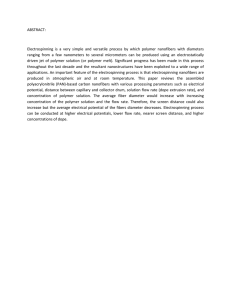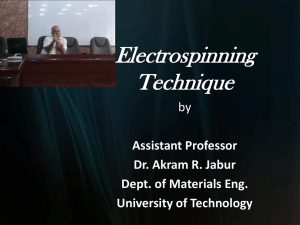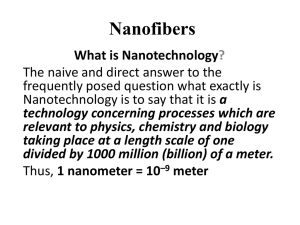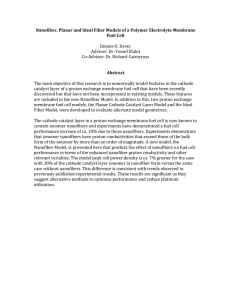Rippling of Polymer Nanofibers - DigitalCommons@University of
advertisement
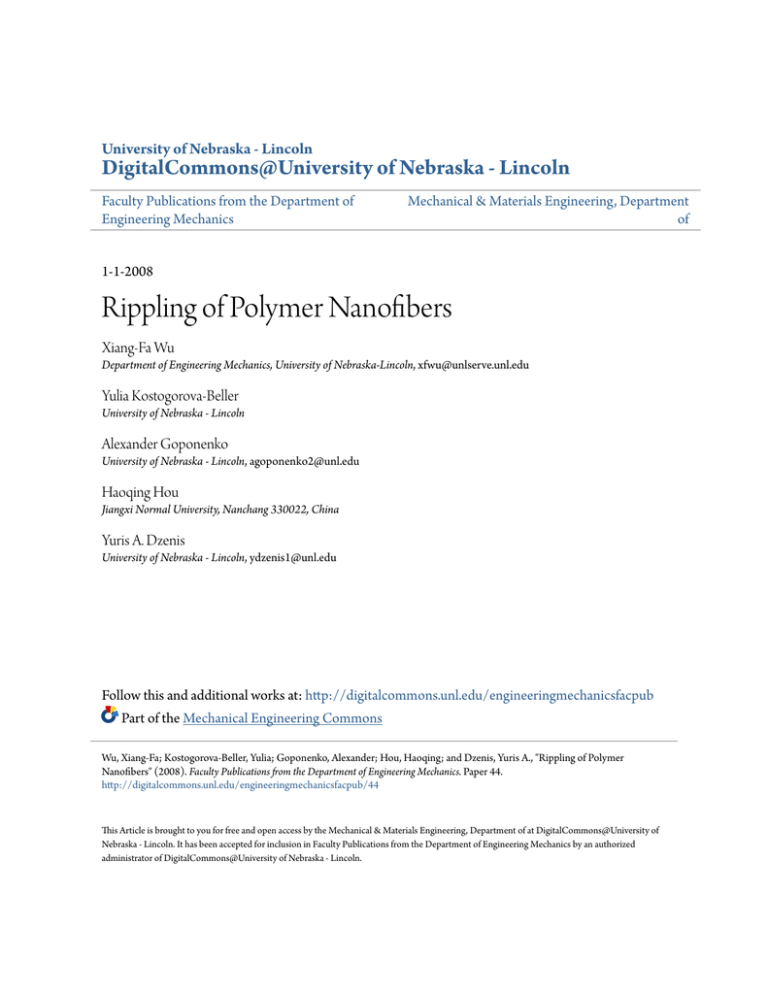
University of Nebraska - Lincoln DigitalCommons@University of Nebraska - Lincoln Faculty Publications from the Department of Engineering Mechanics Mechanical & Materials Engineering, Department of 1-1-2008 Rippling of Polymer Nanofibers Xiang-Fa Wu Department of Engineering Mechanics, University of Nebraska-Lincoln, xfwu@unlserve.unl.edu Yulia Kostogorova-Beller University of Nebraska - Lincoln Alexander Goponenko University of Nebraska - Lincoln, agoponenko2@unl.edu Haoqing Hou Jiangxi Normal University, Nanchang 330022, China Yuris A. Dzenis University of Nebraska - Lincoln, ydzenis1@unl.edu Follow this and additional works at: http://digitalcommons.unl.edu/engineeringmechanicsfacpub Part of the Mechanical Engineering Commons Wu, Xiang-Fa; Kostogorova-Beller, Yulia; Goponenko, Alexander; Hou, Haoqing; and Dzenis, Yuris A., "Rippling of Polymer Nanofibers" (2008). Faculty Publications from the Department of Engineering Mechanics. Paper 44. http://digitalcommons.unl.edu/engineeringmechanicsfacpub/44 This Article is brought to you for free and open access by the Mechanical & Materials Engineering, Department of at DigitalCommons@University of Nebraska - Lincoln. It has been accepted for inclusion in Faculty Publications from the Department of Engineering Mechanics by an authorized administrator of DigitalCommons@University of Nebraska - Lincoln. PHYSICAL REVIEW E 78, 061804 共2008兲 Rippling of polymer nanofibers Xiang-Fa Wu,1,2,* Yulia Y. Kostogorova-Beller,1 Alexander V. Goponenko,1 Haoqing Hou,3 and Yuris A. Dzenis1 1 Department of Engineering Mechanics, Nebraska Center for Materials and Nanoscience, University of Nebraska–Lincoln, Lincoln, Nebraska 68588-0526, USA 2 Department of Mechanical Engineering and Applied Mechanics, North Dakota State University, Dolve Hall 111, Fargo, North Dakota 58108-6050, USA 3 Chemistry and Chemical Engineering College, Jiangxi Normal University, Nanchang 330022, China 共Received 27 March 2008; revised manuscript received 25 September 2008; published 31 December 2008兲 This paper studies the evolution mechanism of surface rippling in polymer nanofibers under axial stretching. This rippling phenomenon has been detected in as-electrospun polyacrylonitrile in recent single-fiber tension tests, and in electrospun polyimide nanofibers after imidization. We herein propose a one-dimensional nonlinear elastic model that takes into account the combined effect of surface tension and nonlinear elasticity during the rippling initiation and its evolution in compliant polymer nanofibers. The polymer nanofiber is modeled as an incompressible, isotropically hyperelastic Mooney-Rivlin solid. The fiber geometry prior to rippling is considered as a long circular cylinder. The governing equation of surface rippling is established through linear perturbation of the static equilibrium state of the nanofiber subjected to finite axial prestretching. The critical stretch and ripple wavelength are determined in terms of surface tension, elastic property, and fiber radius. Numerical examples are demonstrated to examine these dependencies. In addition, a critical fiber radius is determined, below which the polymer nanofibers are intrinsically unstable. The present model, therefore, is capable of predicting the rippling condition in compliant nanofibers, and can be further used as a continuum mechanics approach for the study of surface instability and nonlinear wave propagation in compliant fibers and wires at the nanoscale. DOI: 10.1103/PhysRevE.78.061804 PACS number共s兲: 61.41.⫹e, 82.35.⫺x, 46.25.Cc I. INTRODUCTION Ultrathin polymer fibers with diameter ranging from 1 nm to several micrometers have been produced extensively by the electrospinning technique 关1,2兴. Due to their high surface area to volume ratio, high tensile strength, controllable diameter, surface morphology, and microstructure, as well as low processing cost, electrospun nanofibers are finding rapidly increasing applications as a novel class of one-dimensional 共1D兲 nanomaterials, which include protective clothing 关3,4兴, fine filtration 关5,6兴, nanocomposites 关7兴, templates for producing metallic nanowires and carbon nanotubes 关8,9兴, precursors for synthesizing carbon nanofibers 关10,11兴, biomedical engineering and technologies 共e.g., scaffolds for tissue growth 关12,13兴 and drug delivery systems 关14兴兲, nanosensors and nanoelectromechanical systems 关15,16兴, and microdevices 关17兴, among others. Continuous nanofibers in an electrospinning process can be collected in the form of porous nonwoven mats or aligned nanofibrous films with the aid of auxiliary electrical fields 关18兴. To date, over 200 synthetic and natural polymers have been electrospun successfully into continuous nanofibers. The number of research publications on electrospinning techniques and the resulting fibers has doubled annually in recent years. In addition, several popular review articles have been dedicated to the research progress in nanofiber manufacturing, mechanical characterization, alignment techniques, and potential applications in broad fields 关14,19–24兴. *Author to whom correspondence should be addressed. FAX: 1⫹701-231-8913. Xiangfa.Wu@ndsu.edu 1539-3755/2008/78共6兲/061804共8兲 As in conventional bulk structural and functional materials, the mechanical properties of nanofibers 共e.g., modulus, tensile strength, yielding property, etc.兲 are fundamental to their environmental response and expected functionalities when nanofibers are integrated into nanocomposites and microstructural components. Nanofibers with high strength and high toughness are always desired in view of their end use 关7兴. In addition, fibrous materials at the nanoscale may exhibit unique mechanical behaviors that are essentially different from those of their bulk counterparts. Such unique properties may further influence the deformation, dynamics, stability, adhesion, contact, friction, wetting, and global mechanical response of the resulting nanofilamentary materials and nanodevices 关25–30兴. In recent years, substantial effort has been devoted to understanding the mechanical behavior of individual nanofibers fabricated by electrospinning 关31–38兴. Among these, atomic force microscope 共AFM兲 serves as a typical instrument and has been employed by several research groups for the mechanical characterization 共e.g., axial modulus determination兲 of electrospun nanofibers 关32–35兴. To date, three AFM-based testing methods have been developed: the AFM-based axial tension, three-point bending, and nanoindentation tests. In a typical AFM-based axial tension test, one end of the nanofiber segment is fastened with adhesive onto a substrate 共e.g., a silicon wafer兲, while the other end is tethered to the AFM tip 关34兴. The microscopic tensile force is exerted through the motion of the AFM tip. In the case of a micro three-point bending test, the fiber segment is clamped at two ends with adhesive onto a substrate with periodic gratings 关32,33,35兴. A lateral bending force is exerted through the AFM tip at the midspan of the nanofiber segment between neighboring supports. Furthermore, the axial modulus of nanofibers can also be mea- 061804-1 ©2008 The American Physical Society PHYSICAL REVIEW E 78, 061804 共2008兲 WU et al. sured by means of nanoindentation, similarly to the characterization of thin films. After each test, a force vs displacement or deflection diagram is recorded and the axial modulus can be extracted. Moreover, the axial modulus of nanofibers can also be estimated by measuring the resonant frequencies of a pair of microcantilevers bridged by the nanofiber segments under consideration 关36兴. Nevertheless, the ultimate tensile strength and the strain to failure of nanofibers are arduous to determine using AFM. Indeed, the best way to characterize the mechanical properties of a nanofiber is by direct testing a single nanofiber segment on a microtension tester installed with a highresolution load cell. Newly available high-resolution microtensile testers such as the Nano Bionix and Nano UTM provided by MTS and microelectromechanical-systems共MEMS-兲 based microtensile testers 关37,38兴 make this possible. Presently, full-range highly resolved stress-strain diagrams of nanofiber tension tests can be recorded. For instance, the Nano Bionix has been employed successfully for a uniaxial tension test of polycaprolactone fibers with diameters of ⬃1 m 关39兴. A similar high-resolution microtensile tester was also produced and utilized recently to characterize the modulus and tensile strength of high-strength, hightoughness polyimide 共PI兲 nanofibers with diameters of ⬃300 nm 关31兴. In these tension tests, the tensile force is extremely low, ranging from a few millinewtons to a few micronewtons. Due to the very low tensile force, MEMSbased microtensile testers developed recently may provide an alternative for feasible and accurate measurements 关37,38兴. The above-referenced microtension tests have disclosed two unique behaviors of electrospun polymer nanofibers that are essentially different from those of their large-diameter and bulk counterparts. The first unique behavior is an abrupt increase in axial modulus displayed by a polymer nanofiber when its diameter falls below a certain value 关35,40,41兴. For instance, polystyrene nanofibers demonstrate a rapid increase of the axial modulus when their diameter is below ⬃500 nm; 关40兴 while poly共2-acrylamido-2-methyl-1-propanesulfonic acid兲 nanofibers sharply increase their axial moduli from ⬃300 MPa at the diameter of ⬃110 nm up to ⬃2.0 GPa at the diameter of ⬃55 nm 关40兴. Surface tension may possibly contribute to such an increase in axial modulus according to a recent continuum mechanics calculation 关28兴; however, this explanation is insufficient when trying to understand such fiber behavior occurring below the critical diameter. Therefore, other potential factors need to be further explored. If one considers an electrostatic stretching in the mesojet during the electrospinning process, the observed remarkable size effect can be attributed to a gradual ordering of the microstructure as a function of fiber diameter 关35,41,42兴. As a matter of fact, recently x-ray diffraction has shown that there is only a mild monotonic increase in the crystallinity and orientation of the crystallites inside the polymer nanofibers as a function of fiber diameter 关41兴. As a result, such a mild increase would not be sufficient to account for the observed exceptional increase in the axial modulus. In addition, the above studies further indicated that the average size of crystallites 共⬃4 nm兲 was largely independent of the nanofiber diameter and therefore the crystallinity remained nearly constant in the range of fiber diameter under consideration. To (a) (b) (c) (d) FIG. 1. 共a兲, 共b兲 Scanning electron microscope 共SEM兲 images of surface morphology of as-electrospun PAN nanofibers after tensile breakage. The fiber breakage was induced by extrusion of a 45° conic region. 共c兲 SEM image of the fiber breakage due to the formation of voids. 共d兲 SEM image of ripples formed on PAN nanofiber surfaces subjected to axial stretching 关37,38兴. explore this size effect in the axial tensile modulus of polymer nanofibers, one promising physical mechanism 关42兴 was proposed recently, based on the concept of the supramolecular structure of the amorphous phase, which consists of oriented fragments of the polymer chains. Such supramolecular structures might be formed due to the confinement of polymer nanofibers when the fiber diameter decreases below a certain value. According to this approach, a preliminary estimate was made in predicting the transition fiber diameter, below which the polymer nanofibers may exhibit a noticeable size effect in their axial modulus 关41兴. Yet this approach still leaves an open problem of the likely power-law growth of the axial modulus with decreasing fiber diameter below that certain value. The second unique behavior is the surface rippling in compliant polymer nanofibers subjected to axial stretching. Such surface instability at the nanoscale was first detected in recent MEMS-based microtension tests of as-electrospun polyacrylonitrile 共PAN兲 nanofibers 关37,38兴. In such tension tests, periodic ripples were detected on the fiber surfaces when the axial stretch was up to a certain level as shown in Fig. 1 关37,38兴. It was also discovered during the singlenanofiber tension tests that the PAN nanofibers exhibited no clear softening, and the strain to failure 共in the sense of engineering strain兲 was typically up to 60–130 % for the electrospun PAN nanofibers with a diameter around 300– 600 nm. This strain is several fold greater than that obtained in PAN microfibers produced by drawing and dryjet wet spinning 关37,38兴. In addition, such surface ripples were also found in other electrospun polymer nanofibers, triggered by possible axial contraction after annealing. Figure 2 shows AFM images of the surface morphology of PI nanofibers produced by electrospinning and subsequent imi- 061804-2 PHYSICAL REVIEW E 78, 061804 共2008兲 RIPPLING OF POLYMER NANOFIBERS FIG. 2. 共Color online兲 AFM images of surface morphology of 共a兲 as-electrospun PI precursor nanofiber and 共b兲 PI nanofiber after imidization 共fiber diameter ⬃250 nm兲. dization in our recent study. For smooth PI precursor nanofibers deposited on a silicon wafer in electrospinning, as shown in Fig. 2共a兲, after imidization in a nitrogen environment, surface ripples were detected. This rippling phenomenon may be attributed to the constrained axial shrinking induced in the imidization process. As a matter of fact, the formation of surface ripples on PAN nanofibers is essentially due to a surface instability triggered by the combined effect of surface tension and nonlinear elasticity of the polymer nanofibers. Within the framework of nonlinear elasticity 关43,44兴, necking and surface instability of elastic bars subjected to axial stretching have been well studied, where the effect of surface tension or energy was excluded due to the relatively large diameter and high elastic modulus of the rods. However, at the nanoscale, surface tension may play a crucial role in triggering the surface rippling in compliant ultrathin nanofibers. Therefore, in this study we consider the evolution mechanism of surface rippling in compliant polymer nanofibers subjected to large axial stretching. As a first approach, we propose a simple 1D nonlinear elastic model to examine the combined effect of surface tension and nonlinear elasticity on ripple formation. The governing equation is established through linear perturbation of the static equilibrium state of a prestretched compliant nanofiber. Without loss of generality in capturing the main features, we simplify the compliant nanofiber as an incompressible, isotropically hyperelastic Mooney-Rivlin solid. The critical stretch in triggering the surface rippling and the corresponding ripple wavelength are determined in terms of surface tension, elastic properties, and fiber radius. Numerical examples are demonstrated to examine these dependencies. Furthermore, the present model will be further used to explain the experimental results obtained in recent single-nanofiber tension tests. Then the conclusions and potential applications of the present study are summarized. hyperelastic Mooney-Rivlin solid. In reality, polymer chains inside a polymer fiber may have some extent of preferred orientation and crystallinity owing to the electrostatic stretching in an electrospinning process. For the undisturbed stretch-free state, the imaginary configuration of the nanofiber 共with surface tension ignored兲 is assumed to be a perfectly circular cylinder of radius R0. For the convenience of our discussion afterward, three configurations are adopted to describe the motion of a material point inside the fiber, i.e., undisturbed stretch-free 共with surface tension ignored兲, prestretched 共with surface tension兲, and current configuration 共with surface ripples兲, respectively. The corresponding coordinates of the material point are denoted by 共R , ⌰ , Z兲, 共r , , z兲, and 共r̃ , ˜ , z̃兲, respectively. In the following, we first derive the solution for the prestretched state, and then establish the governing equation of a surface rippling through linear perturbation of the prestretched state. A. Thin solid fibers under axial prestretching When subjected to axial uniform stretching, the axisymmetric deformation of a prestretched fiber can be expressed as r = 1R z = 3Z =⌰ 共0 艋 ⌰ 艋 2兲, 共− ⬁ 艋 Z 艋 + ⬁兲, 共1兲 where 1 and 3 are constants, corresponding to the transverse and longitudinal stretches, respectively. The deformation gradient of the above deformation is 冤 II. MODEL DEVELOPMENT Consider a compliant polymer nanofiber as an infinitely long and thin rod made of an incompressible, isotropically 共0 艋 R 艋 R0兲, r/R 共1/R兲r/⌰ r/Z 冥冤 冥 1 0 0 F = r/R 共r/R兲/⌰ r/Z = 0 0 z/R 共1/R兲z/⌰ z/Z 1 0 . 3 0 共2兲 The material incompressibility of the polymer fiber requires 1 and 3 satisfying 061804-3 PHYSICAL REVIEW E 78, 061804 共2008兲 WU et al. 213 = 1. The resulting left Cauchy-Green tensor B and its inverse are, respectively, B = FFT = diag关21,21,23兴, −1 P = r20共23 − −1 3 兲共2c1 − c23 兲 + r0␥ . 共3兲 −2 −2 B−1 = diag关−2 1 ,1 ,3 兴. 共15兲 The above relation can also be expressed in terms of the radius of a stretch-free fiber 共with surface tension ignored兲 by applying the deformation relation r0 = 1R0 = R0−1/2 3 : −1 −1/2 P = R20共3 − −2 . 3 兲共2c1 − c23 兲 + R0␥3 共4兲 共16兲 The scalar invariants of B are 2 I1 = 221 + 23 = 2−1 3 + 3, I2 = 23 + −2 3 , B. Rippling of thin polymer fibers under axial stretching I3 = 1. 共5兲 The constitutive law of the compliant polymer nanofiber is assumed to obey the equation for a general incompressible, isotropically hyperelastic Mooney-Rivlin solid, which can be expressed in terms of the Cauchy stress tensor vs B: 共6兲 T = − pI + 2c1B + c2B−1 , where p is the hydrostatic pressure, and c1 and c2 are two independent material parameters. In the special case of c2 = 0 and c1 half the shear modulus, a material satisfying the constitutive relation 共6兲 is called a neo-Hookean solid. In terms of stress components, it reads −1 Trr = T = − p + 2c121 + c2−2 1 = − p + 2c13 + c23 , 共7兲 Tzz = − p + 2c123 + c241 = − p + 2c123 + c2−2 3 , 共8兲 Tr = Trz = Tz = 0. 共9兲 Let us now consider the 1D rod equation for a small disturbance superimposed on the prestretched state of the polymer nanofiber in the condition of axisymmetric deformation. For small disturbance, the coordinates of a material point in the current configuration can be expressed as r̃ = 关1 + f共Z兲兴R z̃ = 3Z + g共Z兲 共10兲 T = 0, 共11兲 Tzz = 0. z 共12兲 共13兲 where ␥ 共N/m兲 is the surface tension of the amorphous polymer fiber, which is assumed to be independent of the fiber radius and applied axial stretch in this study, and r0 is the fiber radius in the current configuration after deformation. In addition, along the fiber axis, axial force equilibrium requires P = 2 冕 r0 rTzzdr + 2r0␥ , 共0 艋 ⌰ 艋 2兲, 共− ⬁ 艋 Z 艋 + ⬁兲, 共17兲 F̃ = T B̃ = F̃F̃ = 冤 冤 1 + f 0 f ZR 0 1 + f 0 0 0 3 + gZ 共1 + f兲2 + 共f ZR兲2 0 0 共1 + f兲 f ZR共3 + gZ兲 冥 共18兲 , f ZR共3 + gZ兲 2 0 0 共3 + gZ兲 2 冥 . 共19兲 As a result, the three scalar invariants of B̃ are In the above, two traction boundary conditions 共BCs兲 have been triggered. At the fiber surface, the surface tension leads to uniform compression radically, i.e., Trr = − ␥/r0 , ˜ = ⌰ where f共Z兲 and g共Z兲 are two small disturbance functions satisfying the BCs 共13兲 and 共14兲. The corresponding deformation gradient matrix F̃ and the left Cauchy-Green tensor B̃ can be determined as Furthermore, in spatial coordinates, the equilibrium equations of the axisymmetrically deformed fiber can be written as Trr Trr − T + = 0, r r 共0 艋 R 艋 R0兲, where P is the axial tensile force resultant. The relationship between P and the axial stretch 3 of the fiber can be determined by solving 共10兲–共12兲 under traction conditions 共13兲 and 共14兲 such that 关28兴 共20兲 I2 = 共1 + f兲2关共1 + f兲2 + 共f ZR兲2 + 2共3 + gZ兲2兴, 共21兲 I3 = 共1 + f兲4共3 + gZ兲2 . 共22兲 Material incompressibility of the polymer fiber 共22兲 leads to 共1 + f兲2共3 + gZ兲 = 1. 共23兲 Relation 共23兲 implies that f and g are correlated, and they can be determined through the variational principle applied onto the potential energy of the entire fiber. For the incompressible, isotropically hyperelastic Mooney-Rivlin solid under consideration, the corresponding strain energy density is defined as 关45兴 e = c1共I1 − 3兲 + c2共I2 − 3兲, 共14兲 0 I1 = 2共1 + f兲2 + 共f ZR兲2 + 共3 + gZ兲2 , 共24兲 where I1 and I2 are, respectively, the first and second invariants of the left Cauchy-Green tensor B̃ as given in 共20兲 and 共21兲, and c1 and c2 are two material parameters of the Mooney-Rivlin solid. Thus, the potential energy functional ⌸ of the compliant nanofiber subjected to axial stretching is 061804-4 PHYSICAL REVIEW E 78, 061804 共2008兲 RIPPLING OF POLYMER NANOFIBERS ⌸ = R20 冕 冕 e dZ + 2R0␥ B/A ⬎ 0, 共1 + f兲共3 + gZ兲dZ 共3 + gZ − 1兲dZ. 共25兲 L The three terms in 共25兲 are the contributions due to elastic strain energy, surface energy, and work done by the axial tensile force P, respectively. In addition, in relation 共25兲 material incompressibility has been taken into account, and the integration with respect to Z runs over the entire length of the fiber segment. By substituting 共20兲–共24兲 into 共25兲 and then triggering the variational principle 关27兴 on 共25兲, a second-order nonlinear ordinary differential equation 共ODE兲 can be obtained as R20共1 + c2/c121兲f ZZ − 3关P/共c1R20兲 − 兵6c2/c121 − +2+ 2c2/c1兴−4 1 2␥/共c1R0兲−3 1 + 10−6 1 其f 共26兲 In the case of linear perturbation as used for the study of rippling initiation, f in 共26兲 is a small disturbance from the prestretched state. By eliminating the higher-order terms of f and f Z in 共26兲, a second-order linear ODE can be extracted which governs the rippling initiation, i.e., Af ZZ + Bf + C = 0. 共27兲 Here, the coefficients A, B, and C in 共27兲 are related to the surface energy, elastic properties, fiber geometry 共radius兲, and applied prestretch such that A = R20共1 + c2/c1−1 3 兲, 共28兲 3/2 2 2 B = − 关2 + 6c2/c1−1 3 + 2␥/共c1R0兲3 − 3P/共c1R0兲3 + 6c2/c123 + 1033兴, = 2/k. 共29兲 共35兲 Consequently, relation 共34兲 as well as 共15兲, 共28兲, and 共29兲 determine the rippling condition of compliant polymer nanofibers subjected to axial stretching. III. NUMERICAL EXAMPLES OF RIPPLING DEPENDENCY AND DISCUSSIONS A. Critical condition of surface rippling in compliant polymer nanofibers Based on the rippling condition 共34兲, the critical axial stretch, beyond which rippling happens, can be determined by letting B = 0, 2 − 兵2c2/c131 + 21 − ␥/共c1R0兲−2 1 + 关P/共c1R0兲 −5 − 2c2/c1兴−3 1 − 21 其 = 0. 共34兲 and the corresponding ripple wavelength can be expressed as L L −P 冕 共36兲 i.e., 3/2 2 2 2 + 6c2/c1−1 3 + 2␥/共c1R0兲3 − 3P/共c1R0兲3 + 6c2/c123 + 1033 = 0, 共37兲 where P is the axial force resultant given in 共15兲. It can be proved that Eq. 共37兲 may have one, two, or no real roots depending upon the combined effect of surface tension, elastic properties, and fiber radius. For typical rubbery hyperelastic materials, it guarantees that A ⬎ 0 in 共28兲. Thus, it is expected that for sufficient low loading rate and large fiber diameter, compliant polymer fibers may have only a single necking that happens at B 艋 0 in 共29兲. In such a case, the final fiber breakage takes place at the necking locus as commonly observed in uniaxial tension tests of polymer fibers. In addition, the prestretched polymer fiber under consideration can be understood as follows: the fiber is deformed to a given prestretch in a relatively short time interval and then this constant prestretch is sustained. C = − 关2c2/c1−3/2 + 2−1/2 − ␥/共c1R0兲3 + P/共c1R20兲3/2 3 3 3 共30兲 B. Critical radii for rippling in compliant polymer nanofibers where material incompressibility 共3兲 has been implied. As a matter of fact, surface rippling in a compliant nanofiber implies the existence of periodical solution to Eq. 共27兲. This yields the corresponding characteristic equation: Let us further consider the surface elastic instability of compliant polymer nanofibers in the stretch-free state 共i.e., 3 = 1兲. By setting 3 = 1 in relations 共16兲 and 共37兲, the critical condition B = 0 leads to the critical fiber radius RC: 5/2 − 2c2/c13/2 3 − 23 兴, Af ZZ + Bf = 0. Assume the periodic solution to 共31兲 in the following form: f共Z兲 = A0 exp共ikZ兲, 共32兲 where A0 is the complex amplitude of surface disturbance, and k is the wave number. Therefore, substituting 共32兲 into 共31兲 leads to k = 冑B/A, RC = ␥/关12共c1 + c2兲兴. 共31兲 共33兲 which is a positive number for a physically meaningful rippling surface. As a result, the condition for surface rippling of compliant rubbery polymer nanofibers is 共38兲 Correspondingly, the derivative of B in 共29兲 with respect to R0 in the stretch-free state gives 冏 冏 dB dR0 =− 3=1 ␥ ⬍ 0. c1R20 共39兲 The above relation indicates that for R0 ⬍ RC, B ⬎ 0 holds in the stretch-free state 共3 = 1兲, i.e., below the critical fiber radius RC, rippling can be triggered even without external stretch. In this case, the compliant fibers are intrinsically unstable and therefore cannot be physically produced in reality according to this model. Thus, an initially stable polymer 061804-5 PHYSICAL REVIEW E 78, 061804 共2008兲 WU et al. Material property: c1=0.11 MPa, c2=-0.1 MPa g= 0.025, 0.05, 0.075, and 0.10 N/m Critical axial stretch 4.0 g increases 3.0 2.0 1.0 0.0 Stretch-free state (l3=1) 0 200 400 600 800 1000 1200 Fiber radius (nm) FIG. 3. 共Color online兲 Variation of the upper and lower critical stretches vs the fiber radius for cases of varying surface tension. nanofiber at the stretch-free state 共3 = 1兲 must satisfy B ⬍ 0, i.e., R ⬎ RC according to 共38兲 and 共39兲. Consequently, if solving R0 with the condition B = 0 in 共29兲 and then considering the stationary point satisfying dR0 / d3 = 0, one may obtain the upper limit radius of surface rippling. Beyond this radius, rippling could not happen. It needs to be mentioned that, for the convenience of the above derivation, we have constrained the material in this study to be a general incompressible, isotropically hyperelastic Mooney-Rivlin solid. Such a material model is a feasible approach to handle many rubbery polymers analytically. For as-electrospun PAN nanofibers, our recent experiments indicated that these ultrathin fibers were extremely compliant with very large strain to failure 共around 150%兲 and very large residual plastic strain compared to their counterparts of microextrusion fibers and cast bulk polymers. Nevertheless, in the study of surface rippling, the Mooney-Rivlin material model provides a good approximation by taking into account this large axial stretch and capturing the main features during the rippling process. Hereafter, we demonstrate some numerical examples to examine the rippling dependencies upon fiber radius and prestretch. The elastic constants of the polymer nanofiber, c1 and c2, are selected in the range of typical vulcanized rubber compounds 关46兴 such that c1 = 0.1– 0.31 MPa, c2 = −0.1 MPa, and the surface tension ␥ = 0.025– 0.1 N / m. Figure 3 shows the variation of the upper and lower critical axial stretches needed to trigger the rippling for different fiber radii with varying surface tension. By examining the parameters A and B in 共28兲 and 共29兲, it is found that coefficient A is always positive, while B is a convex function with respect to the axial stretch 3. As a matter of fact, the physically meaningful 3 requires B to be positive, and this leads to the upper and lower critical axial stretches for a given fiber radius and given material properties, as illustrated in Fig. 3. From Fig. 3, one can observe that the upper critical axial stretch decreases with either increasing fiber radius or decreasing fiber surface tension. Meanwhile, the lower critical axial stretch increases with increasing either the fiber FIG. 4. 共Color online兲 Variation of the ripple wavelength vs the fiber radius for cases of varying prestretch. 共Inserted symbols 〫 are the experimental results based on single-fiber tension test 关37,38兴.兲 radius or the surface tension. In addition, Fig. 3 further implies that, for a rubbery nanofiber with diameter below a certain value, the fiber may be naturally unstable as predicted in 共38兲. It can be observed in Fig. 3 that the upper and lower critical axial stretches may overlap at a certain fiber radius. Beyond this critical radius, surface rippling could not happen. As a result, for a given axial prestretch between the upper and lower critical limits, surface rippling may happen according to the present rippling model. The upper and lower limits of critical stretch also determine the range of ripple wavelength of polymer nanofiber rippling under axial stretching. Furthermore, Fig. 4 indicates the variation of the ripple wavelength as a function of fiber radius with varying prestretch between the two upper and lower limits of critical stretch. One can see that the ripple wavelength increases with the increase of either fiber radius or prestretch for given elastic properties and surface tension of the fiber material. For the purpose of comparison between the present model and experimental measurements, the ripple wavelengths and corresponding fiber radii of two types of as-electrospun PAN nanofibers available in the literature 关37,38兴 are plotted in Fig. 4. One can see that the ripple wavelength of the PAN nanofibers as detected in single-fiber tension tests 关37,38兴 共see Fig. 1兲 are located within the wavelength range as predicted in the present model. Indeed, the present continuum mechanics model reveals the rippling mechanism in polymer nanofibers, i.e., the surface rippling phenomenon can be approached within the framework of surface instability of hyperelastic solids. Moreover, the present model can be further refined to take into account other potential factors such as plasticity, viscoelasticity, material compressibility, elastic anisotropy, and dynamics. IV. CONCLUDING REMARKS A 1D phenomenological nonlinear elastic model has been developed which can describe the mechanism of surface rip- 061804-6 PHYSICAL REVIEW E 78, 061804 共2008兲 RIPPLING OF POLYMER NANOFIBERS the rippling initiation remains open. Therefore, further refinement of the rippling model is desired, and needs to include the material plasticity, viscoelasticity, compressibility, and elastic anisotropy. A more detailed approach is expected to provide in-depth understanding of the surface rippling in ultrathin compliant polymer fibers. In addition, pure nonlinear numerical methods 共e.g., the finite-element method兲 can be adopted to capture the entire evolution process of surface rippling and relevant effects of the control parameters. Consequently, the present model discloses the means for developing nonlinear dynamic models important for the analysis of wave propagation in polymer nanofibers that are potentially required for the development of nanofiber transducers, sensors, and other applications. pling in compliant polymer nanofibers subjected to large axial stretch. Based on the assumption of a general incompressible, isotropically hyperelastic Mooney-Rivlin solid, the present model presented reasonable scaling properties of rippling dependencies upon the surface tension, elastic properties, fiber radius, and axial pre-stretch. It can be seen in Fig. 3 that, for polymer fibers of large diameter, rippling may not happen since the upper and lower critical stretches tend to intersect at a certain fiber diameter. In this case, the tensile failure of the polymer fiber is necking-related breakage, as commonly observed in conventional polymer fibers. In addition, the predictions given by the present model can be validated by experimental results obtained in recent single-fiber tension tests. The emphasis should be brought to the point that the actual ripples formed in electrospun polymer nanofibers have significant plastic deformation in a monotonic axial tension test. Such plastic deformation makes it possible to detect the surface ripples by means of a scanning electron microscope or AFM after unloading. The explanation of such an effect on Partial support of this work by the NSF, AFOSR, and ARL is gratefully acknowledged. The work at NDSU was supported by a Faculty Startup Grant. 关1兴 D. H. Reneker and I. Chun, Nanotechnology 7, 216 共1996兲. 关2兴 Y. Dzenis, Science 304, 1917 共2004兲. 关3兴 P. Gibson, H. Schreuder-Gibson, and D. Rivin, Colloids Surf., A 187, 469 共2001兲. 关4兴 H. Schreuder-Gibson, P. Gibson, K. Senecal, M. Sennett, J. Walker, W. Yeomans, D. Ziegler, and P. P. Tsai, J. Adv. Mater. 34, 44 共2002兲. 关5兴 P. P. Tsai, H. Schreuder-Gibson, and P. Gibson, J. Electrost. 54, 333 共2002兲. 关6兴 C. Shin and G. G. Chase, J. Dispersion Sci. Technol. 27, 517 共2006兲. 关7兴 J. S. Kim and D. H. Reneker, Polym. Compos. 20, 124 共1999兲. 关8兴 H. Q. Hou and D. H. Reneker, Adv. Mater. 共Weinheim, Ger.兲 16, 69 共2004兲. 关9兴 C. Lai, Q. H. Guo, X. F. Wu, D. H. Reneker, and H. Hou, Nanotechnology 19, 195303 共2008兲. 关10兴 Y. Wang, S. Serrano, and J. J. Santiago-Aviles, Synth. Met. 138, 423 共2003兲. 关11兴 S. Y. Gu, J. Ren, and G. J. Vancso, Eur. Polym. J. 41, 2559 共2005兲. 关12兴 W. J. Li, C. T. Laurencin, E. J. Caterson, R. S. Tuan, and F. K. Ko, J. Biomed. Mater. Res. 60, 613 共2002兲. 关13兴 H. Yoshimoto, Y. M. Shin, H. Terai, and J. P. Vacanti, Biomaterials 24, 2077 共2003兲. 关14兴 S. Y. Chew, Y. Wen, Y. Dzenis, and K. W. Leong, Curr. Pharm. Des. 12, 4751 共2006兲. 关15兴 K. Sawicka, P. Gouma, and S. Simon, Sens. Actuators B 108, 585 共2005兲. 关16兴 Y. Wang, I. Ramos, and J. J. Santiago-Aviles, IEEE Sens. J. 7, 1347 共2007兲. 关17兴 K. H. Lee, D. J. Kim, B. G. Min, and S. H. Lee, Biomed. Microdevices 9, 435 共2007兲. 关18兴 W. E. Teo and S. Ramakrishna, Nanotechnology 17, R89 共2006兲. 关19兴 Z. M. Huang, Y. Z. Zhang, M. Kotaki, and S. Ramakrishna, Compos. Sci. Technol. 63, 2223 共2003兲. 关20兴 D. Li and Y. N. Xia, Adv. Mater. 共Weinheim, Ger.兲 16, 1151 共2004兲. 关21兴 S. G. Kumbar, S. P. Nubavarapu, J. James, M. V. Hogan and T. Laurencin, Recent Patents Biomed. Eng. 1, 68 共2008兲. 关22兴 E. P. S. Tan and C. T. Lim, Compos. Sci. Technol. 66, 1102 共2006兲. 关23兴 D. H. Reneker, A. L. Yarin, E. Zussman, and H. Xu, Adv. Appl. Mech. 41, 43 共2007兲. 关24兴 R. Ramaseshan, S. Sundarrajan, R. Jose, and S. Ramakrishna, J. Appl. Phys. 102, 111101 共2007兲. 关25兴 X. F. Wu and Y. A. Dzenis, J. Appl. Phys. 98, 093501 共2005兲. 关26兴 X. F. Wu and Y. A. Dzenis, J. Appl. Phys. 100, 124318 共2006兲. 关27兴 X. F. Wu and Y. A. Dzenis, Acta Mech. 185, 215 共2006兲. 关28兴 X. F. Wu and Y. A. Dzenis, J. Appl. Phys. 102, 044306 共2007兲. 关29兴 X. F. Wu and Y. A. Dzenis, Nanotechnology 18, 285702 共2007兲. 关30兴 X. F. Wu and Y. A. Dzenis, J. Phys. D 40, 4276 共2007兲. 关31兴 F. Chen, X. W. Peng, T. T. Li, S. L. Chen, X. F. Wu, D. H. Reneker, and H. Q. Hou, J. Phys. D 41, 025308 共2008兲. 关32兴 E. P. S. Tan and C. T. Lim, Rev. Sci. Instrum. 75, 2581 共2004兲. 关33兴 E. P. S. Tan, C. N. Goh, C. H. Sow, and C. T. Lim, Appl. Phys. Lett. 86, 073115 共2005兲. 关34兴 E. Zussman, M. Burman, A. L. Yarin, R. Khalfin, and Y. Cohen, J. Polym. Sci., Part B: Polym. Phys. 44, 1482 共2006兲. 关35兴 M. K. Shin, S. I. Kim, S. J. Kim, S. K. Kim, H. Lee, and G. M. Spinks, Appl. Phys. Lett. 89, 231929 共2006兲. 关36兴 P. A. Yuya, Y. K. Wen, J. A. Turner, Y. A. Dzenis, and Z. Li, Appl. Phys. Lett. 90, 111909 共2007兲. 关37兴 M. Naraghi, I. Chasiotis, H. Kahn, Y. K. Wen, and Y. Dzenis, Appl. Phys. Lett. 91, 151901 共2007兲. 关38兴 M. Naraghi, I. Chasiotis, H. Kahn, Y. Wen, and Y. Dzenis, Rev. Sci. Instrum. 78, 085108 共2007兲. 关39兴 E. P. S. Tan, S. Y. Ng, and C. T. Lim, Biomaterials 26, 1453 共2005兲. ACKNOWLEDGMENTS 061804-7 PHYSICAL REVIEW E 78, 061804 共2008兲 WU et al. 关40兴 Y. Ji, B. Q. Li, S. R. Ge, J. C. Sokolov, and M. H. Rafailovich, Langmuir 22, 1321 共2006兲. 关41兴 A. Arinstein, M. Burman, O. Gendelman, and E. Zussman, Nat. Nanotechnol. 2, 59 共2007兲. 关42兴 C. T. Lim, E. P. S. Tan, and S. Y. Ng, Appl. Phys. Lett. 92, 141908 共2008兲. 关43兴 B. D. Coleman, Arch. Ration. Mech. Anal. 83, 115 共1983兲. 关44兴 H. H. Dai and Z. Cai, Acta Mech. 139, 201 共2000兲. 关45兴 Y. B. Fu and R. W. Ogden, Nonlinear Elasticity: Theory and Applications 共Cambridge University Press, Cambridge, U. K., 2001兲. 关46兴 L. T. G. Trelorar, The Physics of Rubber Elasticity 共Clarendon, Oxford, 1975兲. 061804-8
